Introduction
With the Centennial of the University Museum approaching, various projects on its history are under way, and some may appear from time to time in Expedition: this article is one such. Although outside the normal range of our articles, it is not however as far removed from scholarly work as might appear at first glance, since the Women’s Committee, like all component parts of the Museum and its operations, exists ultimately to promote and assist research and education; moreover, it has in fact played such a role many times in direct support of these primary functions.
The Women’s Committee thus has been far more than a pleasant social group, for it has acted not only to identify problems but to solve them. Some of these have been directed toward the comfort and sociability of both staff and visitors, such as the inception of the ‘Coffee Shop’; but even such welcome activities as this are by no means purely social in intent or in effect—generations of staff and students can attest to the stimulus that the ‘Coffee Shop’ has given to intellectual life! Other projects of the Women’s Committee have been directly beneficial to the Museum’s main operations —its contributions to the Conservation Laboratory for both training and equipment are an obvious example.
It may seem curious that an almost autonomous group should be sanctioned to identify problems and to solve them. But, as in any large organization, the official management has its hands full with longterm policies, finances, and day-to-day problems to the extent that it cannot fairly be expected to foresee and deal with every conceivable issue. Thus, in practice, it has largely worked very well to have an essentially independent ‘ginger group’ seeking out areas for improvement and attempting to implement those improvements.
—Editor
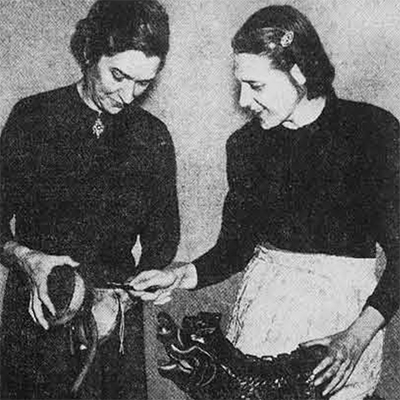
The University Museum will hold its Centennial Celebration in 1987 and, according to Percy C. Madeira, Jr. in his book Men in Search of Man, the Museum was “born under favorable stars.” The time and place were right and the community “was blessed with both scholars and dollars.” The 100-year history of this great museum will be fully researched, chronicled and published in the next four years. The Women’s Committee as a supporter and partner during the last fifty of these impressive years has played a significant role.
The Committee was born under less favorable stars during the years between the Depression and World War II, when times were unpropitious for fund raising but dinner and social events at the Museum were a great success, under the supervision of the wives of the Board of Managers. It seemed logical that such an effective group become a part of the Museum. At the suggestion of the President, John Story Jenks, in 1939 the Women’s Committee was formed by Mrs. Daniel Moreau Barringer, the widow of one Museum Board member and the mother of another, Brandon Barringer. Many of the original Committee were wives or relatives of the members of the Board of Managers, and had been involved in planning and arranging dinners, receptions and other Museum social functions. It was the woman’s touch in a structured way that was needed to add warmth to the environment and to stimulate community interest in the Museum.
Among the first written reports of activities of the newly formed Committee is a letter discussing “necessities and embel lishments” and the purchase of cretonne curtains for decorating a dressing room. Housekeeping interests were paramount and a memorandum to the Board in 1940 called attention to the inadequacy of the antique lavatories which had not been improved for forty years. In the same memorandum the Committee informed the Board that they had undertaken the financing of a diorama of a Lenape Village for the Educational Department. Such was the scope of interest of the Women’s Committee.
The Committee was effectively organized by the following year and Mrs. Barringer prepared a thoughtful and productive set of recommendations.
The first suggestion was to place every object of value under the protective covering of glass. Originally, practically every thing was in locked cases, but with the general tendency to ‘open’ exhibitions in the 1930s, Mr. Jayne removed many cases. The engagement of the Mexican designer, Antonio Lebrija, by Dr. Vaillant in the early ’40s made for further ‘openness.’ Today, not only are cases completely sealed, but circumstances require highly sophisticated technical security.
A second recommendation was to equip the entrance with fuller information concerning the collections, and the “ladies deemed it essential to have pamphlets for distribution in the popular Babylonian and Persian galleries.” The Committee also requested the use of maps and photographs as part of the display. It further recommended that invitations be sent to Museum members to visit galleries after Saturday lectures with special tours to behind the scenes activities accompanied by a Department member and a Women’s Committee member.
It projected a plan to increase interest in the Museum with monthly exhibitions devoted to different collections and highlighted by subscription dinners. In a period of few expeditions in the field, this would provide incentive to attract visitors to the Museum.
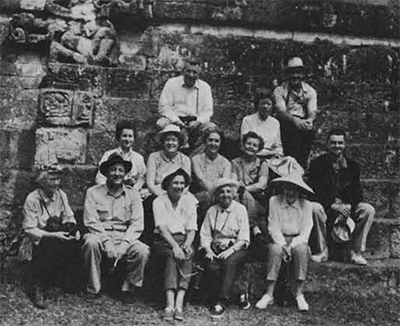
At the same time the Committee members began to understand the Museum as a community asset to young people. They initiated discussions with the staff and assisted in contacting schools to again use the Museum as a resource and to investigate ways to bring school children into the Museum. It should be remembered that lectures for school children given by the curators had been popular from early days. The Educational Department was formed in September 1921 with Helen Fernald as Head Docent. Work with children (and others) continued, but on a less formal basis. All Museum activities suffered during the Depression. The suggestions of the Women’s Committee for reactivating programs were most welcome.
The fruition and finalization of their plans for Volunteer and Mobile Guides were to take place much later but ideas were initiated.
Simultaneously the Committee was beginning to reach out to the community in an effort to increase membership by mailing personal invitations to friends and acquaintances to become Museum members —and membership did increase.
In digging into the early archives, it becomes obvious that the founding members of the Women’s Committee, though interested in improving housekeeping and excelling in the social graces, nevertheless had broader awareness of the possibilities of their role. They took an interest in providing programs and services to the Museum that the busy staff, involved in research and field work and in keeping the Museum functioning, had no time to pursue. Even in the formative years, the Committee was planting seeds for projects to be developed.
In 1943, Mr. Percy C. Madeira, Jr., who was President of the Board of Managers, wrote a letter to Mrs. Barringer requesting that she make every effort to hold the Women’s Committee together during those difficult times of gas rationing and preoccupation with wartime activities. He suggested that their work at the Museum was important to the staff and that, though they were unable to hold regular meetings, their activities on behalf of the Museum should continue.
It is interesting to note that in 1944 the balance in the Women’s Committee account was $40.89, so it was obviously not the financial help at this time which made the Committee of value to the Museum.
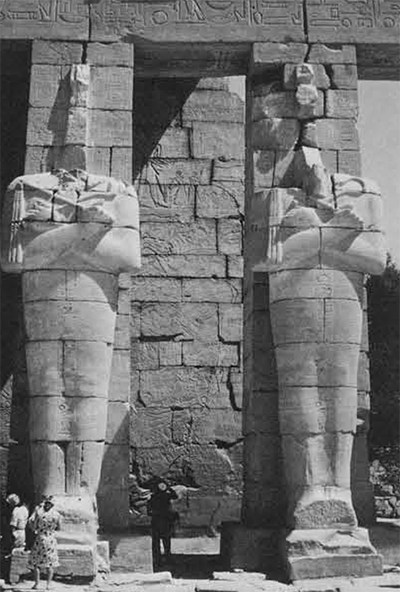
Shortly after the end of the war the minutes of a meeting indicate that the Committee members again felt they had an obligation to entertain and “unanimously echoed their enthusiasm” for one big party a year. At the same time they committed themselves to the inauguration of a lecture series. Mrs. William Godfrey, later to become Mrs. Francis Boyer, the Secretary of the Museum, suggested for the first series “our new Chinese Curator, Dr. Cammann, who is very intelligent and talks well, Dr. Coon, who has just returned from Iran and might amuse the ladies, and of course Dr. Kramer who always delights.” The lecture series began with luncheons prepared by the Committee and according to one member, Mrs. Nancy Lamont, the person who was the best cook ran the series. This touch of frivolity does not diminish the importance and the service the lectures provided to the Museum over a long period of years. In 1958, in addition to the luncheon series of lectures, a new series at 5:30 followed by cocktails was initiated. Members of every department of the Museum participated, as well as other internationally distinguished scholars. The series continued through 1978 when the Museum took over the sponsorship.
An important event occurred in 1946 when the Board of Managers invited two members of the Women’s Committee to accompany them on their monthly inspection of the Museum and to attend Board Meetings. It was not however until 1948, when Mrs. Charles C. Harrison, Jr. became Chairman of the Committee, that this connection with the Board of Managers became official. Mrs. Harrison was not only efficient and attractive, but dynamic and forceful. Since 1955 the Women’s Committee Chairman has been a member of the Board of Managers (renamed Overseers in 1981) and has had the privilege of inviting another member to attend each meeting. In 1982, when the Women’s Committee was under the leadership of Mrs. Cummins Catherwood, Jr., the Board of Overseers agreed that a member of the Women’s Committee be appointed to each of its Standing Committees.
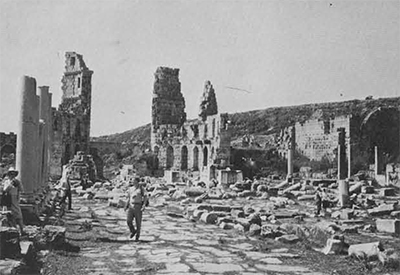
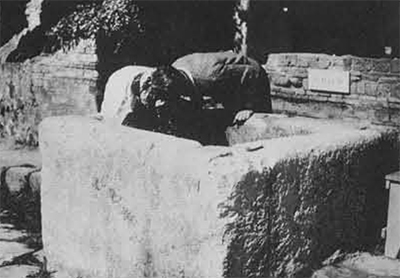
The period of the late ’40s, under the newly appointed Director, Dr. Froelich Rainey, was one of expansion and growth in the Museum. A distinguished curatorial staff was engaged and a huge network of expeditions was extended throughout the world. Gibeon, Gordion, Hasanlu, Tikal became household words in the halls of the Museum. With this greater field work came increased interest in making the Museum inviting and exciting to the public.
Developing’ along the sidelines and throughout this activity was a changing style in the Women’s Committee. No longer were meetings confined to lengthy discussions of parties, caterers, menus and wine.
The women wanted to be informed and productive. They continued to sponsor social functions to help raise money for projects, they continued to solicit prospective members, to work in the library, to work with curators, to wash Etruscan pots, to sort sherds from Iran, to clean and paint casts for sale in the Museum Shop, and to check trays of Pacific artifacts. Each curator continued to request assistance and received it with alacrity and enthusiasm. Though the ladies still wore hats to meetings, there was no job too dirty, dusty or challenging.
In the ’50s the Women’s Committee organized and supported one of three concert series given at the Museum on Sundays. Obtaining a piano for these recitals became increasingly difficult, but in 1953 through the interest and intervention of a Committee member, a Steinway piano was donated to the Museum by Efrem Zimbalist and the Curtiss Institute. After this time the Committee recognized that its role in the concerts was completed and it seemed a natural evolution to turn the running of the concert series over to the Museum. Thus was established a precedent which continues until the present.
The direction of the Women’s Committee constantly changes with developments in the Museum and the talent and creativity of the individuals on the Committee. As the Committee recognizes areas where needs exist it initiates and supports programs until they become a part of the Museum structure.
The Committee recognized that no place existed in the Museum to offer refreshments. Mrs. Pierre Fraley, the youngest member of the Committee and “shockingly pregnant but handsome in a glorious turban of many colors” volunteered to survey the Museum for a suitable location. With the approval of the Board of Managers she plunged into a needs assessment, sought and found a place that would provide a pleasant atmosphere, and ordered the equipment. In 1951 the Brazilian Coffee Shop opened in the area now occupied by the gift shop, with the capacity to serve forty-five people soup, sandwiches, pastry and beverages. Although by 1959 the Coffee Shop needed additional space, it was not until the completion of the new wing in 1971 that space was provided. Again the
Women’s Committee, now under the leadership of Mrs. Francis Pell, harnessed its energies and organized the details of running a restaurant. A committee, chaired by Mrs. Earl Scott, interviewed and hired a catering service and supervised the entire operation when the restaurant opened in 1971. Serving a large variety of food, moderately priced, in an expanded and handsome setting, the Potlatch is now run as an independent concession under Museum management.
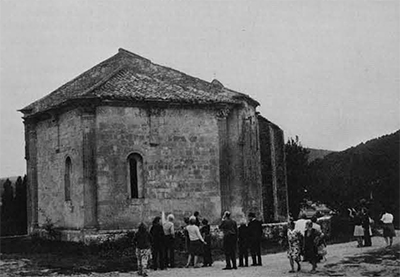
With the increased volume of activity in the Museum, it became essential to have a vehicle for informing Museum members. There had been scholarly publications for many years: the Museum Journal, then the Bulletin which later became Expedition. For several years a Calendar was published but this was not substantive and did not adequately communicate Museum activities to the entire membership. Under the guidance of Geraldine Bruckner and the Women’s Committee Chairman, Mrs. Anna Biggs, several volunteers began to structure a new publication and in 1963 with Mrs. E. F. Rivinus as editor, the first edition was distributed. Three issues were to be published yearly. Today the Newsletter, researched, written and edited by the Women’s Committee, continues to be published under the supervision of Jennifer Quick. The format has totally changed and there are currently four issues a year. It gives members a sense of personal involvement in the Museum and informs them on a variety of subjects such as lectures, exhibits, travel and research, Museum personalities and services. It is a forum which all Museum departments are encouraged to use.
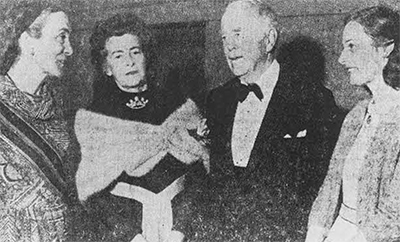
The planting and maintenance of the gardens was always a great concern to the Women’s Committee and the letters and minutes in the archives are filled with references to landscaping problems. In 1952 the Committee contributed funds to the Museum for planting with a proviso that the University assume responsibility for the upkeep. The care of the garden continued in this informal arrangement until 1963 when Mrs. Anna Biggs asked Mrs. Clarence Warden to take over the Garden Committee, Mrs. Warden undertook the challenge of redesigning and replanting the garden. She skillfully unearthed funds, hired an outstanding landscape architect, purchased plant material, prevailed upon the Women’s Committee to support and the Board of Managers to accept her plans. Under her able direction and with much of her own hard work, gardens flourished.
A Garden Fund was subsequently established which has been used to improve and help maintain the gardens. The Women’s Committee has recently received a generous pledge to the Garden Fund from Mrs. Warden. Added to the Committee’s own budgeted figure, this will insure that the gardens continue in the image originally conceived by Mrs. Warden and will bring constant pleasure to Museum visitors.
In 1982 the University Museum garden won an award given by the Greater Philadelphia Chamber of Commerce and the Horticultural Society in the category of “best gardens of over 1 acre of a nonprofit institution.”
Two major volunteer programs in the Museum were founded by the Women’s Committee and nurtured to subsequent independence. A volunteer docent program began to evolve in 1959 when Madeleine Crosby (Morrison], then Secretary of the Women’s Committee, Kenneth Matthews, Director of Education, Mary Virginia Harris, a volunteer at the Museum, and Mrs. Pierre Fraley from the Women’s Committee, met to exchange ideas. Volunteer guides were rare in those days, and visits were made to several out of town museums, and reports on the findings presented to the group. Several efforts were made to get the program started. In 1962, Sandra Lovell arranged for Geraldine Bruckner, the Registrar, to take those interested in guiding on a tour of the Museum. According to all attending, it was inspirational. The first guides, a small group of women, started a program of intensive research and seminars, with the added bonus of weekly talks by the curators. In the course of researching the Museum galleries, a handbook called a Guide to the Collections was written and later published. The guides have been a great addition to the Museum and now operate under the Department of Education. They can be seen daily leading school children through the galleries, escorting groups from organizations, guiding for special exhibitions and relieving the regular docents on weekends.
The Mobile Guides were the inspiration of Mrs. Francis Lewis, who with Mrs. Earl Scott organized the project in 1973 with great assistance from Caroline Dosker. The purpose of the program is to carry anthropology, archaeology and ethnology into the community. Portable exhibits are taken to the schools with artifacts which the children can touch and hold. After a period of extensive training volunteers, working in teams of two, give informal instruction to groups of ten students from first to sixth grades, meeting twice with each group. To date, the subjects covered are Northeastern Woodland Indians, Ancient Egypt, and Classical Greece and Rome. The school children participating are given the enriching exposure to these cultures and there continues to be a great demand for the program which has been endorsed by the Philadelphia Board of Education and supported by the Parent Teacher Association.
The decade of the ’60s was a productive period for the Committee, While some members were busy with the gardens and the docents, others began to recognize the unusual opportunity the University Museum has to organize tours. Lectures which had attracted non-members as well as members to the Museum proved a nucleus for the first travel program. It was a challenging idea to arrange a tour to a site where a current dig was in progress. In 1962 the Museum’s first tour departed for Copan and Tikal with Dr. Alfred Kidder, II as lecturer. The number was limited as the only available airplane in that area had a capacity for only nine passengers. The travelers were hardy adventurers. Such hardihood is still required on some of today’s tours. Since 1962 tours have made important contributions to the Museum. They provide an opportunity to visit the great archaeological sites of the world accompanied by curators who have often played a major role in the excavations. They have attracted interested travelers from throughout the country and have added another constituency and image to the Museum. Funds raised through tour gifts have made possible many of the Committee’s programs and contributions to the Museum. Tours continue to be the greatest and most consistent source of income.
Another significant if not readily visible project launched by the Women’s Committee was the establishment of the Conservation Laboratory in 1966. Largely through the vision and vigilance of Mrs. Hyland Dilks, funds for the purchase of furniture and equipment, as well as for the hiring of part-time assistants, were initially contributed. The Women’s Committee, under the leadership of Mrs. Richard Bull, provided funds for the present conservator, Virginia Greene, to study for two years in London, and later in 1976 to attend several international conferences. While it was originally intended that the Women’s Committee contribute ‘seed money’ for conservation, in fact they consistently helped support the program, and in 1976 Women’s Committee funds were made available for a Conservation Fellowship. After 1976 the program became partially self-supporting with the aid of a grant from the William Penn Foundation. Today it is an integral department of the Museum with a staff engaged in preserving, storing and maintaining, with the greatest technical skill and standards, the great store of material housed in the University Museum, so that future generations as well as those living today may be able to study and enjoy it.
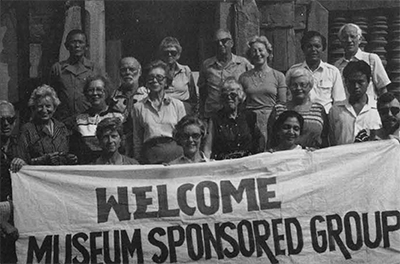
Throughout the decades of the ’70s and ’80s the Women’s Committee has continued to assume the responsibility for a variety of fund-raising activities in addition to auctions, fairs, dinners and lectures. It has sponsored projects for the Museum Shop, including needlepoint and jewelry designs created by individual Committee members. Minutes in 1960 describe Mrs. Clark Zantzinger, in addition to her many organizational talents, instructing Committee members in the art of designing and making necklaces. Wonderful Egyptian jewelry was made for sale in the shop by Mrs. Albert H. Rosengarten.
In 1972 a group of the members, under Mrs. Cummins Catherwood, Jr. and Mrs. Daniel Hutchinson, III, took full responsibiIity for creating and managing a shop for children. This ‘Pyramid Shop’ has been a financial success as well as a pleasant spot for the thousands of school children who visit the Museum each year. The one problem that has plagued the shop is the inevitable school strike. Experience, good management and wise counsel have helped overcome this difficulty.
Individual members of the Women’s Committee have been most generous and cooperative in supporting projects which make the Museum a more attractive and hospitable place to visit. Improvements in facilities and equipment, a cornerstone of the early Committee, continue to be a concern. Among the Committee’s recent contributions are new carpeting, uniforms for the guards, front hall repairs and improved sound equipment in both the Rainey and Harrison Auditoriums. Through the imagination of one member of the Committee, the Nevil Gallery for the Blind and Partially Sighted was planned, financed and completed. A generous contribution by the Committee in 1978 and 1979 was responsible for partial funding for renovations for the Archives Room.
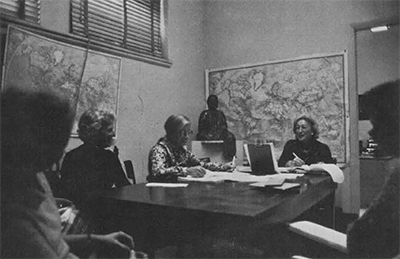
In the efforts of the Women’s Committee to identify different objectives and to enhance the public image of the Museum, it provided funds in 1971 and 1972, when there was no other visible support, to improve public relations. In 1978 additional allocations were made for a part-time Public Relations Director. In recognition of the significance of this work, in 1980 a full time Public Information Officer was added to the staff and has become a tremendous factor in developing public interest in the Museum on a national level.
No history of the Women’s Committee would be complete without the acknowledgment of the services of David Crown-over, who for many years served as liaison between the Women’s Committee and the Administration, and of the past three Executive Secretaries of the Women’s Committee. They have had an integral part in the development of all Committee activities Madeleine Crosby Morrison was a “petite ball of fire full of ideas and very efficient” and had a strong influence on the Committee during her long tenure. When her resignation was submitted in 1968 prior to her moving out of the city, a grateful Committee tendered her an emotional farewell party. Bereft but determined to replace her, the Committee engaged in an intensive search. In 1969 Margaret Pugh came to work for the Women’s Committee. With a deep sense of loyalty for the Museum, a wonderfully contagious sense of humor and a heightened concern about the public image of the Museum and the Women’s Committee, Mrs. Pugh was an energetic and positive force. When the Committee added to her responsibilities the work of part-time Public Relations Director, additional help was needed in the office. A very eager, attractive and capable young woman was hired to assist. She learned quickly and when Mrs. Pugh left in 1979 Sydney Cheston stepped into the job which she has since been filling most competently.
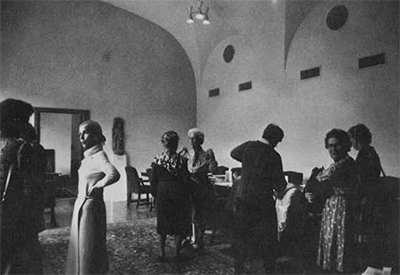
The composition of the Women’s Committee has changed in the past 44 years, but not drastically. The group is more diverse and more compatible with the broad-based Museum objectives—no longer there to serve only as hostesses. Fortunately, many of the women who are now Associate Members have been on the Committee for over 25 years and are still active. They have an understanding and an appreciation of the Museum which is contagious, and the newer members have profited from association with them. This is an unusual Women’s Committee, proud to be involved with a research, teaching and educational institution of great stature, and constantly striving to help it achieve it aims in the most appropriate way.
The Women’s Committee of the University Museum has enjoyed the unique privilege of working in an academic environment of scholarship and beauty with directors, curators and staff who have given constantly and generously of their time and expertise to make its projects and programs effective. The archives indicate some periods of stress and differences of approach but good judgment and mutual respect have prevailed. The current administration under Dr. Robert Dyson has a strong commitment to interdependence and cooperation and the Women’s Committee, for its part, pledges to aid and support the Museum with renewed dedication as we move into the next century. We are all of us looking forward to the Centennial Celebration as a milestone in the life of the museum which Percy Madeira wrote was “born under favorable stars.”
